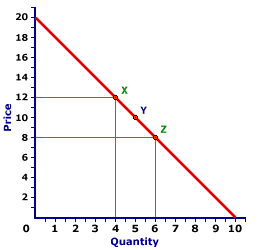
|
|
POLITICAL PHILOSOPHIES: The range of philosophical orientations that people have about politics, especially concerning the role of government. While a wide range of differing opinions exist, most tend to fall on a spectrum bound by liberal views on one end and conservative views on the other. Liberals tend to favor a larger role of government and conservatives tend to favor a smaller role.
Visit the GLOSS*arama
|
|


|

|
                           ARC ELASTICITY: The average elasticity for discrete changes in two variables. The distinguishing characteristic of arc elasticity is that percentage changes are calculated based on the average of initial and ending values of each variable, rather than initial values. Arc elasticity is generally calculated using the midpoint elasticity formula. The contrast to arc elasticity is point elasticity. For infinitesimally small changes in two variables, arc elasticity is the same as point elasticity. Arc elasticity is best considered the average elasticity over a range of values for a relation. Like any average, some values within the range are likely to be greater and some less. However, it provides a quick approximation of elasticity when more precise and sophisticated calculation techniques are not possible.Working Through an Example| A Standard Demand Curve |  |
The demand curve displayed to the right can be used to illustrate the measurement of arc elasticity using the midpoint elasticity formula. If the price declines from $12 to $8, the quantity demanded increases from 4 to 6, from point X to point Z. Using this midpoint formula (with price designated as P and quantity designated as Q) average price elasticity of demand is:midpoint
elasticity | = | (Q[Z] - Q[X])
(Q[Z] + Q[X])/2 | ÷ | (P[Z] - P[X])
(P[Z] + P[X])/2 |
midpoint
elasticity | = | (6 - 4)
(6 + 4)/2 | ÷ | (8 - 12)
(8 + 12)/2 | = | (2)
(5) | ÷ | (-4)
(10) |
midpoint
elasticity | = | 0.4 | ÷ | -0.4 | = | -1.0 |
Ignoring the minus sign, the price elasticity of demand over this segment of the demand curve from X to Z is 1.0.An Average ValueThis value of 1.0 is actually an average for the entire range between points X and Z. Precise estimates of point elasticity shows that the elasticity is 0.67 at point X and 1.5 at point Z. Moreover, the elasticity is different at each point on a straight line demand curve such as this one. The only point in which the elasticity is exactly equal to 1.0 is at point Y, the midpoint between X and Z.This last observation is worth emphasizing. The midpoint elasticity formula effectively estimates the point elasticity at the very midpoint of the overall segment. This means that the elasticity of any point on a demand curve (point elasticity) can be obtained by calculating the arc elasticity with the midpoint elasticity formula such that the desired point is dead center in the middle, the midpoint of the arc.

Recommended Citation:ARC ELASTICITY, AmosWEB Encyclonomic WEB*pedia, http://www.AmosWEB.com, AmosWEB LLC, 2000-2025. [Accessed: June 30, 2025].
Check Out These Related Terms... | | | | | |
Or For A Little Background... | | | | | |
And For Further Study... | | | | | |
Search Again?
Back to the WEB*pedia
|



|

|
|
General Electric is the only stock from the original 1896 Dow Jones Industrial Average remaining in the current index.
|

|
|
"I learned about the strength you can get from a close family life. I learned to keep going, even in bad times. I learned not to despair, even when my world was falling apart. I learned that there are no free lunches. And I learned the value of hard work. " -- Lee Iacocca
|

|
UNCTAD
United Nations Conference on Trade and Development
|

|
|
Tell us what you think about AmosWEB. Like what you see? Have suggestions for improvements? Let us know. Click the User Feedback link.
User Feedback
|


|


